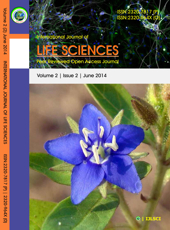Screening of Heavy Metal Resistant Bacteria from Nale Lake of Vasai Taluka of Maharashtra
Keywords:
Heavy metals, Bioaccumulators, Vasai Taluka, Nale LakeAbstract
Due to rapid industrial progress and urbanization environmental pollution with toxic heavy metal has become one of the major concerns in today’s world. We need advance chemical and mechanical technology for removal of heavy metals from polluted water, but this technology is quite expensive. Microbial technologies and inventions may provide an alternative to the current methods. Microorganisms and microbial products can be highly efficient bioaccumulators for heavy metals. In this study, preliminary investigation showed presence of few heavy metal resistant bacteria from a lake of Vasai Taluka situated in Nale village. Different isolates showed different degree of resistance to Arsenic, Lead and Cadmium proving that they can be used as tools for remediating the water contaminated with these toxic heavy metals. Further investigations need to be carried out to identify and characterize the isolates so as to establish their role as bioaccumulators.
Downloads
References
1. Abosamra F Nahhas R Zabalawi N Baba S Taljo G and Kassoumeh F (1989) Trace metals and petroleum hydrocarbons in Syrian coastal waters and selected biota species. In Marine Pollution ed. Albaiges J. pp. 185-200. New York: Hemisphere Publishing Corp.
2. Arbneshi T Rugova M and Berisha L (2008) The level concentration of lead, cadmium, copper, zinc and phenols in the water river of Sitnica J. Int. Environmental Application & Science, 3(2): 66-73.
3. Beveridge TJ and Murray RGE (1980) Site of metal deposition in the cell wall of Bacillus subtilis. J. of Bacteriology, 141: 876-887
4. Grimalt JG (1989) Sampling, sample handling, and operational methods for the analysis of trace pollutants in the marine environment. In Marine Pollution ed. Albaiges J. New York, Washington, Philadelphia, London: Hemisphere Publishing Corp.
5. Gupta UC and Gupta SC (1998) Trace element toxicity relationships to crop production and livestock and human health: implications for management. Communications in Soil Science and Plant Analysis, 29:1491-1522
6. Kermanshahi RK Ghazifard A & Tavakoli A (2007) Identification of Bacteria Resistant to Heavy Metals in the Soil of Isfahan Province. Iranian Journal of Science & Technology, Transaction A: 31-38
7. Low KS Lee CK and Liew SC (2000) Sorption of cadmium and lead from aqueous solution by spent grain. Process Biochemistry, 36: 59-64
8. Makokha AO Mghweno LR Magoha HS Nakajugo A and Wekesa JM (2008) Environmental Lead Pollution and Contamination in Food around Lake Victoria, Kisumu, Kenya. Afric. J. Environ. Sci. Tech., 2(10): 349-353
9. Mandal BK and Suzuki KT (2002) Arsenic around the world: a review. Talanta, 58: 201-235
10. Nriagu JO. (2002) Arsenic poisoning through the ages. In: Fragenberger WT Jr (ed.) Environmental Chemistry of arsenic. Marcel Dekker, New York, pp. 1-26.
11. Sabry SA, Ghozlan HA and Abou-zeid DM (1997) Metal tolerance and antibiotic resistance patterns of a bacterial population isolated from sea water. J. Appl. Microbiol., 82: 245-252.
12. Spivak J (1981) Copper, nickel and cadmium in the Mediterranean. In NATO Workshop Trace Metals in Sea Water.
13. Tang XY Zhu YG Cui Duan YS and Tang L (2006) The effect of ageing on the bioaccessibility and fractionation of cadmium in some typical soils of China. Environment. International, 32: 682-689.
14. Traxler RW and Wood EM (1990) Bioaccumulation of metals by Coryne form SL-1. J. Indust. Microbial. 6: 249-252
15. Volesky B (1990) Biosorption of Heavy Metals, pp.408, Boca Raton, FL: CRC Press Inc, ISBN 0-84934917-6.27) .
16. Washington JA and Sutter VL (1980) Dilution susceptibility test: agar and macro-broth dilution procedures. In Manual of Clinical Microbiology, 3rd edn. Lennette EH Balows A, Hauler WJ and Truant JP pp. 453-458. Washington, DC: American Society for Microbiology.
Downloads
Published
How to Cite
Issue
Section
License
Copyright (c) 2014 Authors

This work is licensed under a Creative Commons Attribution-NonCommercial-NoDerivatives 4.0 International License.
Open Access This article is licensed under a Creative Commons Attribution 4.0 International License, which permits use, sharing, adaptation, distribution and reproduction in any medium or format, as long as you give appropriate credit to the original author(s) and the source, provide a link to the Creative Commons license, and indicate if changes were made. The images or other third party material in this article are included in the article’s Creative Commons license unless indicated otherwise in a credit line to the material. If the material is not included in the article’s Creative Commons license and your intended use is not permitted by statutory regulation or exceeds the permitted use, you will need to obtain permission directly from the copyright holder. To view a copy of this license, visit http://creativecommons.org/ licenses/by/4.0/











